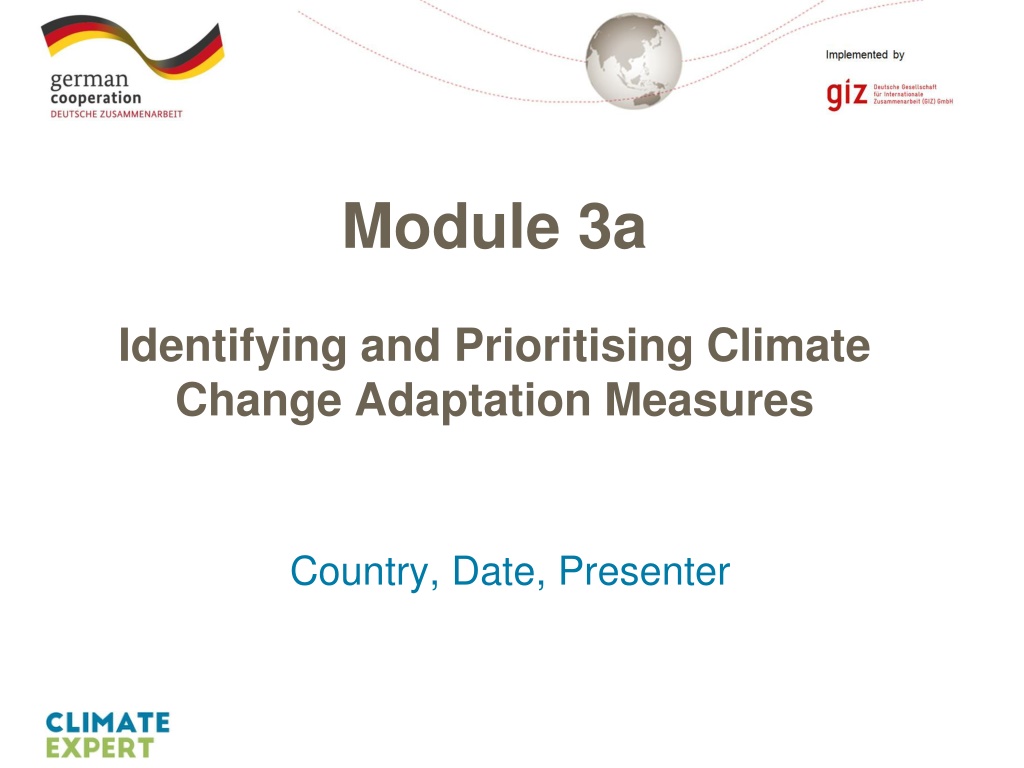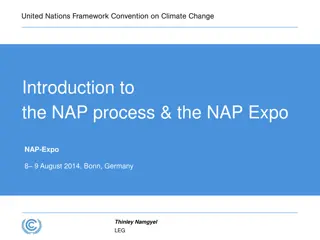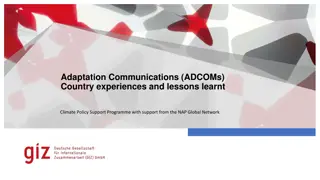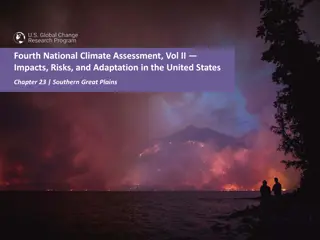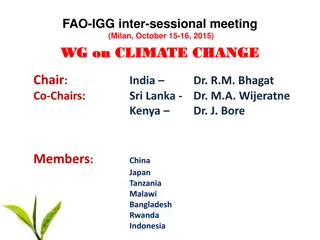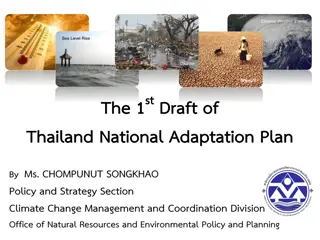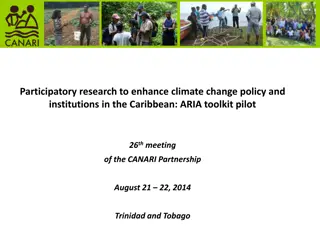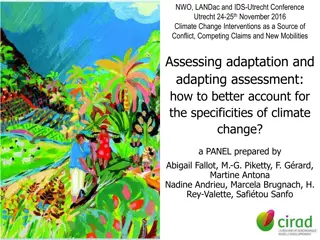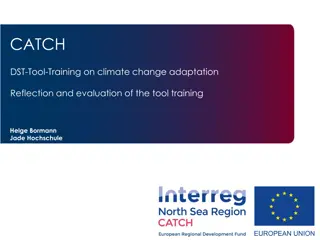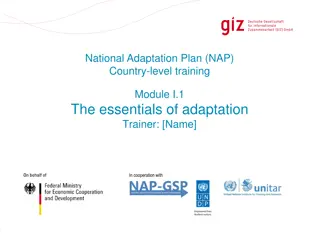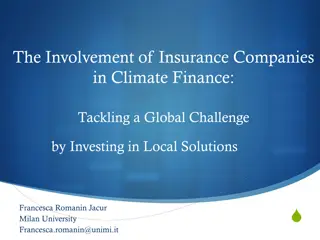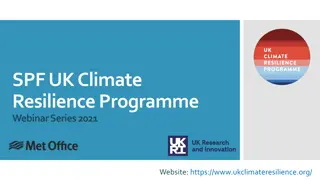Understanding Climate Change Adaptation Measures and Strategies
This module delves into identifying and prioritizing climate change adaptation measures by exploring various strategies, positive side effects, and competitive advantages. Through definitions, examples, and case studies, it highlights the importance of adaptation strategies in responding to climate challenges effectively.
Download Presentation

Please find below an Image/Link to download the presentation.
The content on the website is provided AS IS for your information and personal use only. It may not be sold, licensed, or shared on other websites without obtaining consent from the author. Download presentation by click this link. If you encounter any issues during the download, it is possible that the publisher has removed the file from their server.
E N D
Presentation Transcript
Module 3a Identifying and Prioritising Climate Change Adaptation Measures Country, Date, Presenter Page 1
Objective The objectives of this module are to: learn about adaptation measures and strategies get to know different types of positive side effects review by which criteria adaptation measures are compared and prioritized ToC - Module 3a Page 2
Outline / Agenda I. Adaptation Strategies & Measures II. Selection of Adaptation Measures III. Positive Side-Effects and Competitive Advantage ToC - Module 3a Page 3
I. Adaptation Strategies & Measures ToC - Module 3a Page 4
I. Adaptation Strategies & Measures - Definition An adjustment in natural or human systems in the response to actual or expected climate stimuli (variability, extremes, changes) or their effects, which moderates harm or exploits beneficial opportunities Source: IPCC TAR 2001 = Managing climate risks and opportunities for survival and growth ToC - Module 3a Page 5
I. Adaptation Strategies & Measures - Adaptation Strategy Adaptation strategy plays a key role in this process: The better the strategy, the better the company s response to climate change! Strategy is "the determination of the basic long-term goals of an enterprise, and the adoption of courses of action and the allocation of resources necessary for carrying out these goals. Source: Peter Drucker ToC - Module 3a Page 6
I. Adaptation Strategies & Measures - Flood protection measure timing and integration Company severely affected Adaptation made afterwards No anticipation of impacts and / or no action Reactive Adaptation Company anticipates changes and prepares for them Company somewhat affected Improvements made to single measure Anticipatory Adaptation Company anticipates and prepares for changes, integrates them into to its biz model / supply chain Company might even profit Improvements made to strategy Integrated Adaptation Time Flooding occurs ToC - Module 3a Page 7
I. Adaptation Strategies & Measures - Overview After being clear about the adaptation strategy, you have to opt between different adaptation measures. These comprise technical (grey), ecosystem-based (green), or solutions concerning management issues (soft). Grey Green Soft Multiple factors influence the nature of adaptation measures, which in the end, must also coincide with your adaptation strategy: For example, ask yourself if a measure should only be cost-effective or also contribute to achieving social and environmental co-benefits? ToC - Module 3a Page 8
I. Adaptation Strategies & Measures - Technical measures (grey) Technical measures chiefly reduce the physical vulnerability of a company, locations of production or processing Examples: insulation for buildings, flood- and storm-resistant construc- tion of buildings, physical barriers to protect buildings from flooding Features: immediate risk reduction, medium- and long-term pay-offs ToC - Module 3a Page 9
I. Adaptation Strategies & Measures - Green adaptation measures (green) Ecosystem-based adaptation measures often make use of and equally sustain ecosystems and their services Examples: installation of flood storage areas, planting of trees, green roofs and walls Features: low-cost, flexible solutions to increase the adaptive capacity and to limit climate change impacts ToC - Module 3a Page 10
I. Adaptation Strategies & Measures - Managerial adaption measures (soft) Managerial solutions do not include physical infrastructure but rather deploy digital services or knowledge and capacity building measures Examples: monitoring of environmental data and adaptation progress within the company, taking up climate change relevant insurance (e.g., flood insurance), formation of a climate adaptation team Features: adaptation to increase the internal / organisational capacity and ability to deal with climate change ToC - Module 3a Page 11
I. Adaptation Strategies & Measures - Adaptation options Win-win actions contribute to adaptation whilst also having other social, economic and environmental policy benefits, including those relating to mitigation Adaption measures can be classified according to the benefits they yield. Win- Win options No-regret actions are cost -effective under current climate conditions and are consistent with addressing risks of climate change, they possess no hard trade-offs with other policy objectives Low-regret actions are relatively low cost and provide relatively large benefits under predicted future climates No regret options Low regret options Adaptation options Flexible/ adaptive mgmt. Flexible or adaptive adaptation options involve putting in place incremental adaptation options rather than undertaking large-scale adaptation at one point in time Source: UKCIP & Martin ToC - Module 3a Page 12
I. Adaptation Strategies & Measures - Example: Response of a food processor facing more heatwaves Negative effects on the business in the area of Buildings and infrastructure Processes Potential adaptation measures Secure and increase water sources Water recycling system Logistics and stock Heat-resistant roof for storage depot Employees and community Market Collaboration with community for joint water management Product offer with heat-protecting packaging Credit for energy efficiency investment Finance ToC - Module 3a Page 13
I. Adaptation Measures and Strategies - Example: Response of a chemical company to flooding risks Negative effects on the business in the area of Buildings and infrastructure Potential adaptation measure Secure most important machinery from floods Processes Close unwanted leakages Logistics and stock Emergency plan for keeping up supply to market Employees and community Market Emergency plan for employees Regional diversification of buyer base Finance Insurance against damages from extreme weather ToC - Module 3a Page 14
II. Selection of Adaptation Measures ToC - Module 3a Page 15
II. Selection of Adaptation Measures - Overview of steps in strategizing adaptation Select risks to address from the risk assessment Identify measures (grey, green, soft) Assess measures according to criteria After having picked several adaptation measures, it is crucial to scrutinize their suitability and effectiveness by an array of criteria. Select measure(s) to be implemented ToC - Module 3a Page 16
II. Selection of Adaptation Measures - Multi-Criteria Analysis Multi-Criteria Analysis can be used to evaluate and rank the shortlisted measures Potential for risk reduction Feasibility Technical feasibility Internal feasibility (skills) Investment and running costs Positive side effects / Competitive advantage Grey Potential for cost reductions Synergies with other measures Positive environmental and social impacts Reversibility Green Soft Negative side effects On climate / environment / community On existing processes and approaches ToC - Module 3a Page 17
II. Selection of Adaptation Measures - Multi-Criteria Analysis The criteria partly contain several sub-aspects. To simplify, the following questions give you an understanding about each one s core objective: Potential for risk reduction: How helpful is the measure? Will it be necessary to implement additional measures to fully tackle the risk? Feasibility: Does the company have the required resources to implement the measure? Positive side effects / competitive advantage: Does the measure have positive effects on aspects of the business which had not been targeted by it? Negative side effects: Will other aspects of the business, the environment, or external stakeholders such as communities suffer from the implementation of the measure? ToC - Module 3a Page 18
III. Positive Side Effects and Competitive Advantage ToC - Module 3a Page 19
III. Positive Side Effects and Competitive Advantage Example: Cost savings through risk reduction measures Adaptation measures that while reducing risks entail positive side- effects, are especially attractive. Drip irrigation as a response to lowered rainfall, for example, mitigates the vulnerability of collapsing groundwater aquifers (risk reduction) and decreases operational costs (gains in competitiveness). JobyElliott, CC BY 2.0 Alongside positive side effects, adaptation measures may also cause negative effects. ToC - Module 3a Page 20
III. Positive Side Effects and Competitive Advantage Four Types 1. Operations Opportunities for cost reduction in operations 2. Reputation Opportunities for improving a company s reputation among key stakeholders Competitive advantage resulting from risks reducing measures 3. New skills and repositioning Opportunities for developing the skill-base of the future 4. Regulation Opportunities for anticipating regulation and becoming a first-mover ToC - Module 3a Page 21
III. Positive Side Effects and Competitive Advantage Operations Competitive advantage through cost reduction How? Introducing technologies / measures which reduce the resource intensity of production processes and products Benefits Cost savings through greater efficiency and effectiveness Integrated water-, waste- and energy management Example Reduces vulnerability to climate change impacts Reduces costs due to lower resource consumption ToC - Module 3a Page 22
III. Positive Side Effects and Competitive Advantage New Skills and Repositioning Competitive advantage through a strategic repositioning Review internal processes and skills: are they adequate to address risks and seize opportunities from adaptation? Innovate internal processes to be future-ready Reposition skill-base towards future-oriented markets How? Benefits Long-term sustainability of the business Competitive advantage through early repositioning Implement training programmes on energy-efficiency for your staff Example Integrate an environmental engineer in your team who can increase the resource efficiency of your products ToC - Module 3a Page 23
III. Positive Side Effects and Competitive Advantage Reputation Competitive advantage through greater trust by stakeholders Through dialogue, marketing and cooperation activities which target the community, company staff and their families, local authorities, customers and investors How? Consumer loyalty, social peace with regard to community, better access to financing, improved relations with government institutions Benefits Projects with communities to develop and implement adaptation measures benefiting company and community Example Avoid conflicts with neighbouring communities Demonstrate social responsibility ToC - Module 3a Page 24
III. Positive Side Effects and Competitive Advantage Regulation Competitive advantage from anticipating regulation Monitor developments in the regulatory field concerning adaptation topics (water efficiency, toxic discharge etc.) How? Engage in dialogue with policy makers Prepare your business for potentially upcoming regulation Advantage over competitors as you achieve compliance early on, while competitors are punished for non-compliance Benefits Early access to upcoming support or funding schemes Example Keep yourself informed about regulatory developments through participation in industry fora, dialogue processes etc. Develop actions plans / implement measures proactively ToC - Module 3a Page 25
Discussion Climate Change Phenomena, Impacts & Adaptation How well are SMEs in your country planning or implementing adaptation measures already? Generally speaking, what kind of adaptation measures do you find most appealing? A lot of attention was paid to the positive side effects: Have you had experience with negative side effects? ToC - Module 3a Page 26
Thank you for your attention! Company Company Trainer 1 Telephone number E-Mail address Trainer 2 Telephone number E-Mail address Homepage Homepage Knowledge partner ToC - Module 3a Page 27
Sources CSC, GIZ, Wageningenur, & BMUB, 2011 : Climate Fact Sheet Rwanda, extract from Climate Report 2011. Available at: http://www.climate-service- center.de/imperia/md/content/csc/kongo/fact_sheet_climate_rwanda.pdf C2ES, 2011: Extreme weather and Climate Change. Available at: http://www.c2es.org/publications/extreme-weather-and-climate-change C2ES 2013: Weathering the Storm: Building Business Resilience to Climate Change. Available at http://www.c2es.org/docUploads/business-resilience-report-07-2013- final.pdf GIZ & adelphi 2013: Trainers Maunal. Facing the Impacts of Climate Change. Indian SMEs and Climate Change. Available at: https://www.giz.de/de/downloads/giz2013-en-trainer-manual-sme_small.pdf Martin, Suzanne: Examples of no-regret, low-regret and win-win adaptation actions. Available at: http://www.climatexchange.org.uk/files/6713/7365/7183/adaptation_noregret_actions.pdf McKinsey & Company 2015: How Companies can Adapt to Climate Change. Available at: http://www.mckinsey.com/business-functions/sustainability-and-resource- productivity/our-insights/how-companies-can-adapt-to-climate-change UKCIP: Identifying Adaptation Options. Available at: http://www.ukcip.org.uk/wp-content/PDFs/ID_Adapt_options.pdf ToC - Module 3a Page 28
